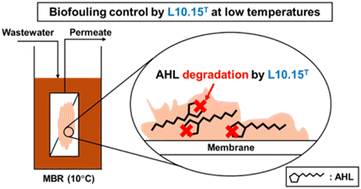Application of psychrotolerant quorum quenching Planococcus versutus sp. L10.15T to membrane bioreactors for biofouling control at low temperatures†
Abstract
Bacterial quorum quenching (QQ) (e.g., degradation of N-acyl homoserine lactones (AHLs)) has been utilized to mitigate biofouling in membrane bioreactors (MBRs). However, the anti-biofouling efficiency of QQ bacteria may decrease at low temperatures. To enhance the resilience of QQ technology to cold climates, psychrotolerant Planococcus versutus sp. L10.15T was applied to MBRs at 10 °C in the form of polymeric beads entrapping L10.15T. The efficiency of AHL degradation by L10.15T-beads was compared to that by beads entrapping Rhodococcus sp. BH4, a QQ bacterium that has been widely used in MBRs at room temperature. The AHL degradation by the L10.15T-beads was more efficient than that by the BH4-beads for most types of AHLs tested at 10 °C. The application of the L10.15T-beads to a continuous MBR at 10 °C exhibited that the anti-biofouling efficiency of L10.15T was greater than that of BH4 through more effective reduction in extracellular polymeric substances in the biocake on the membrane surface.



 Please wait while we load your content...
Please wait while we load your content...